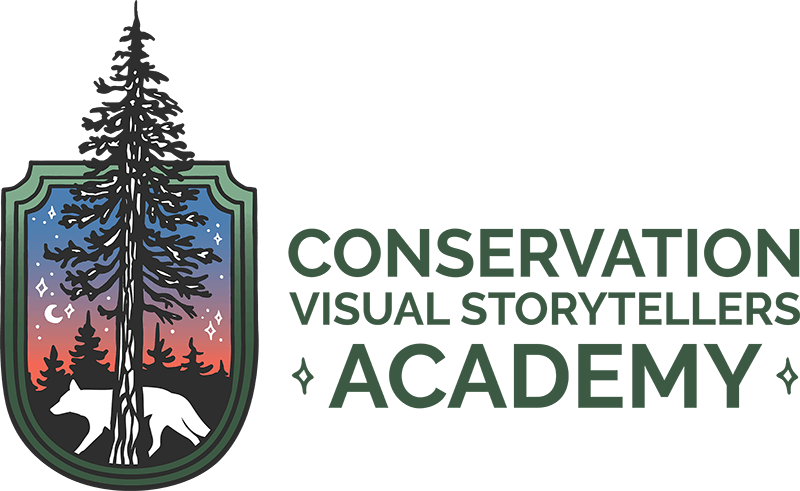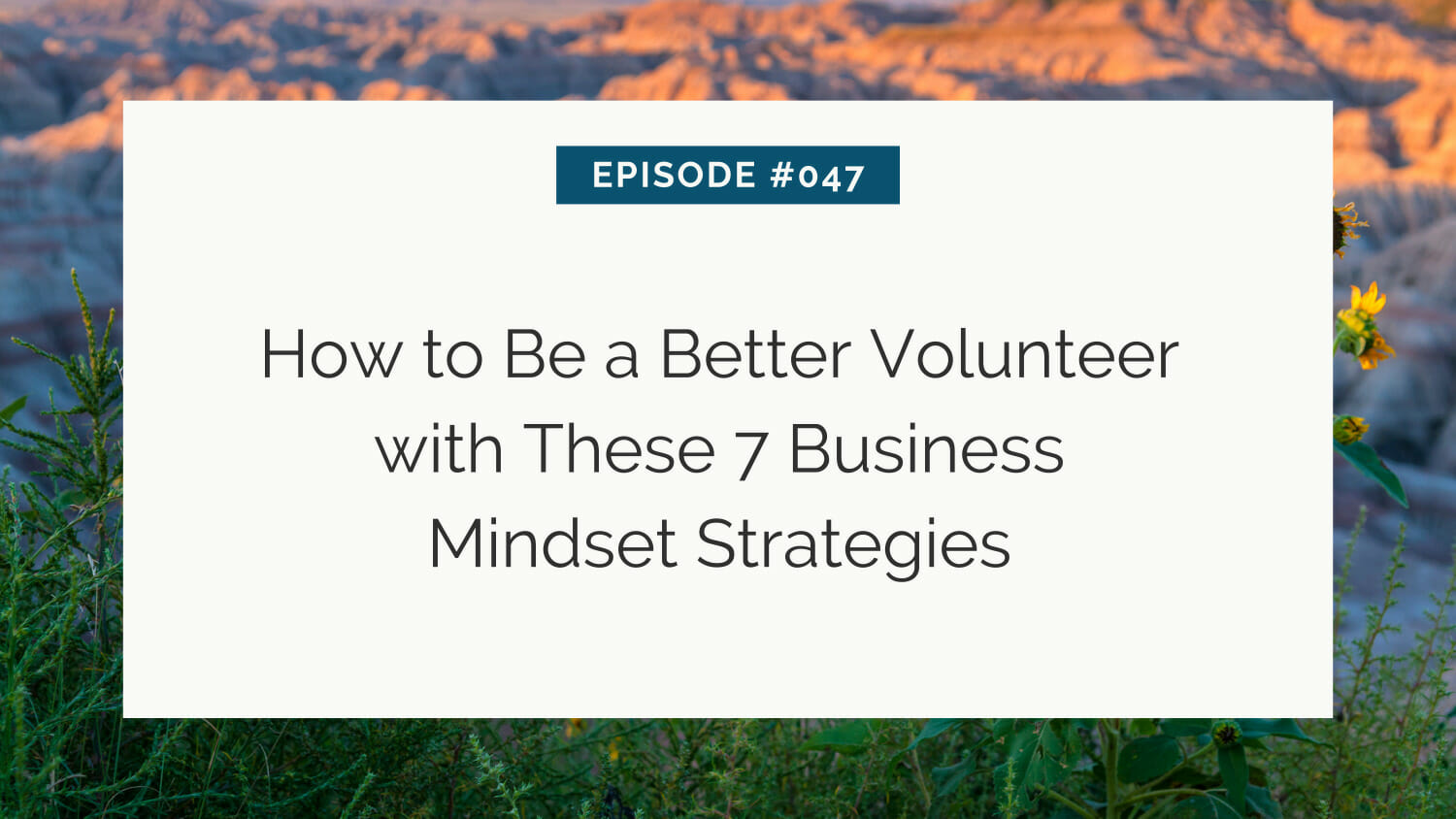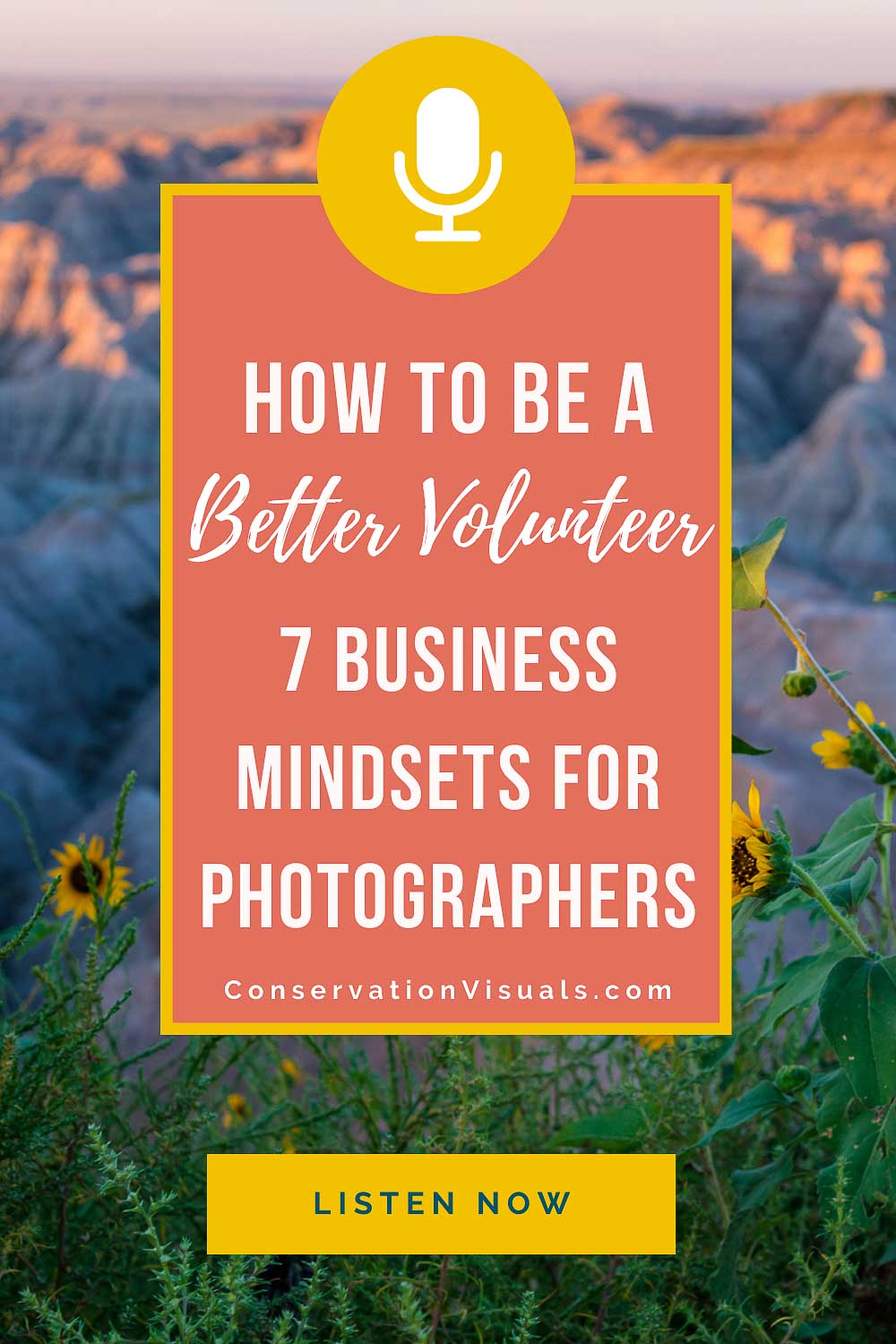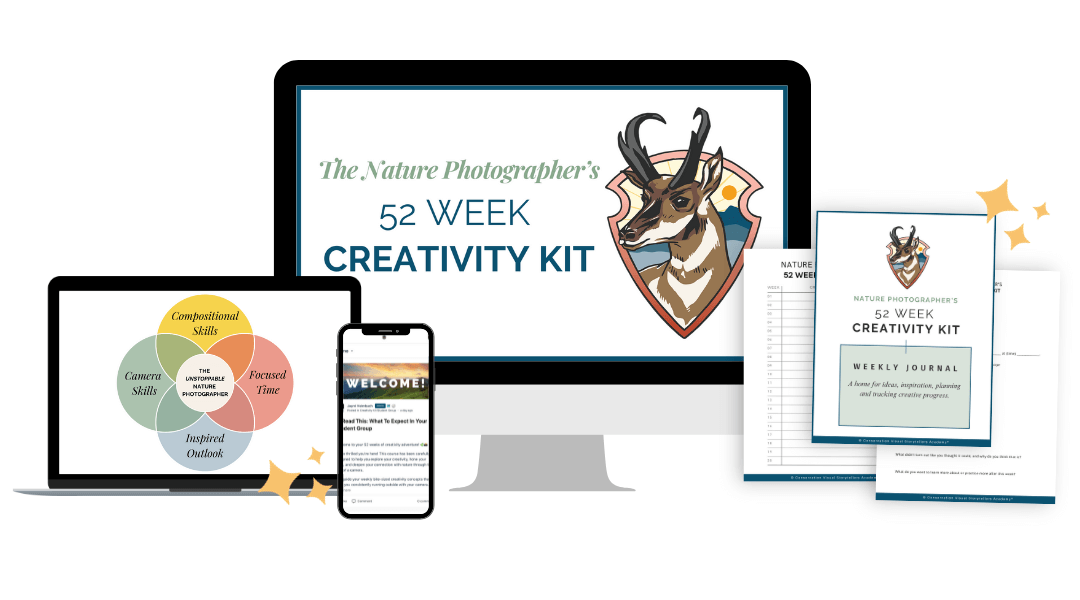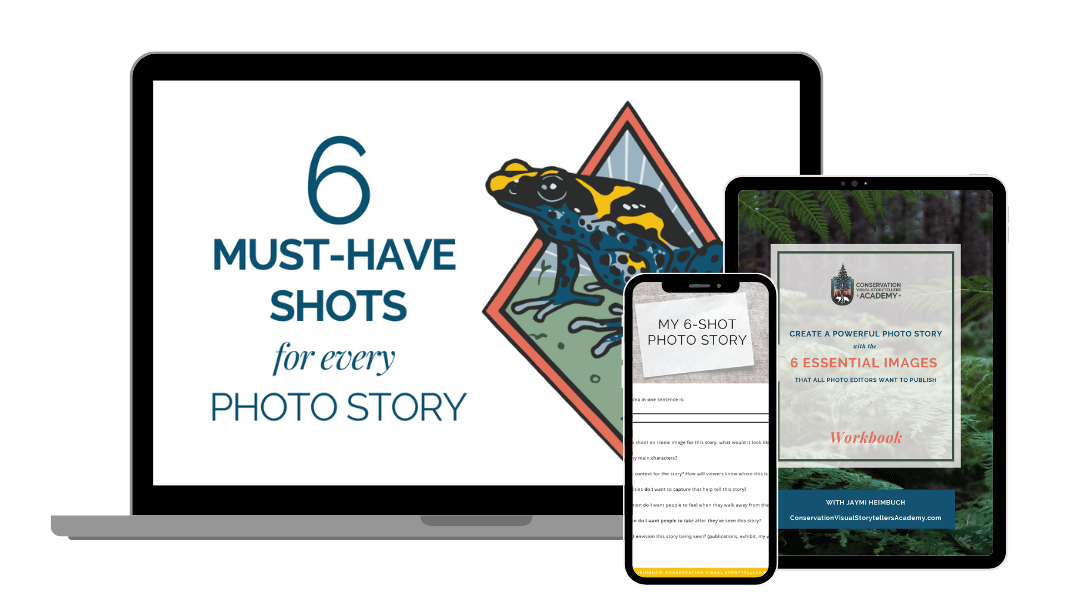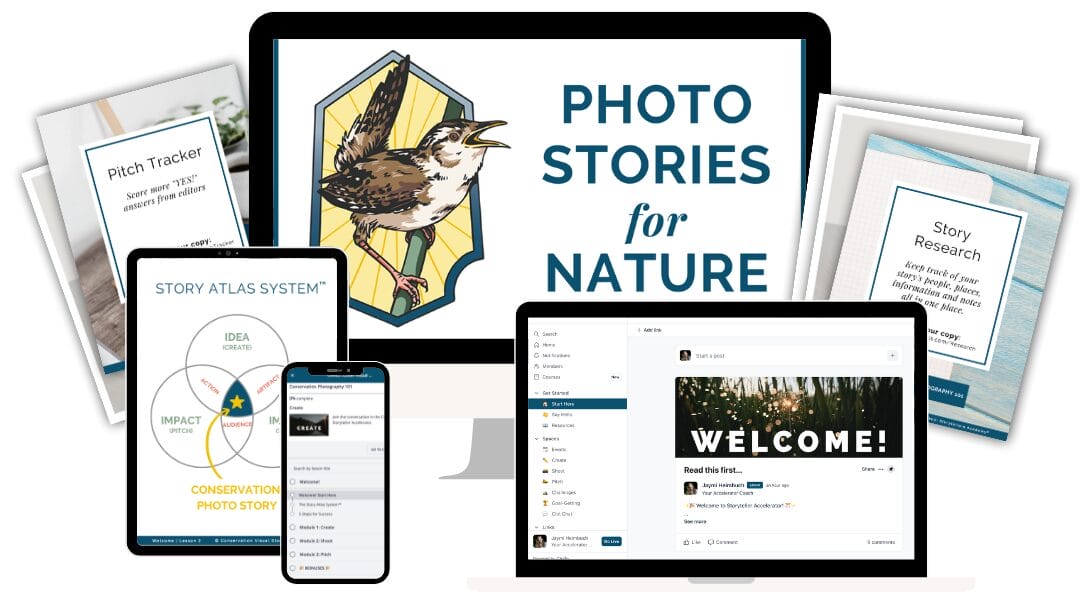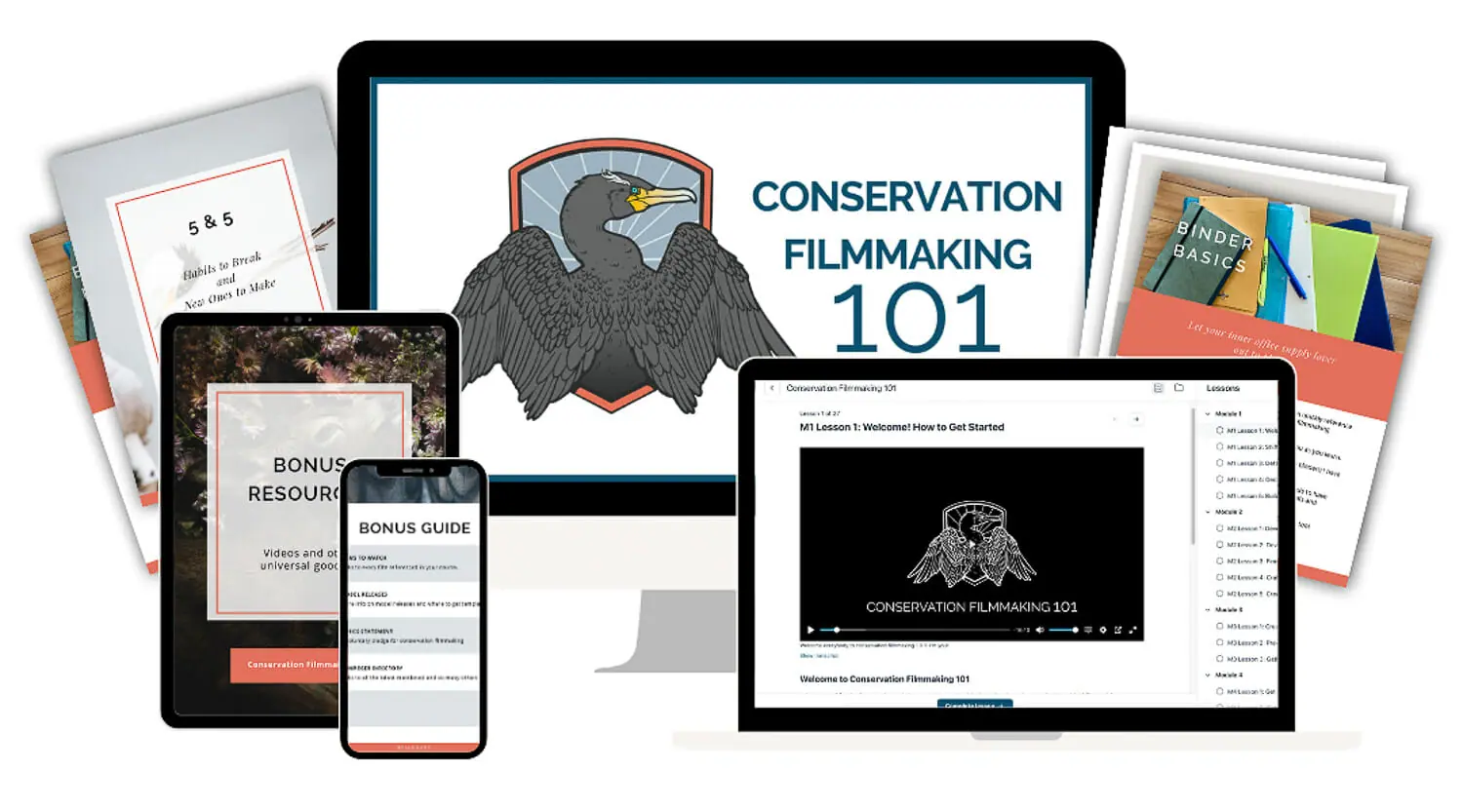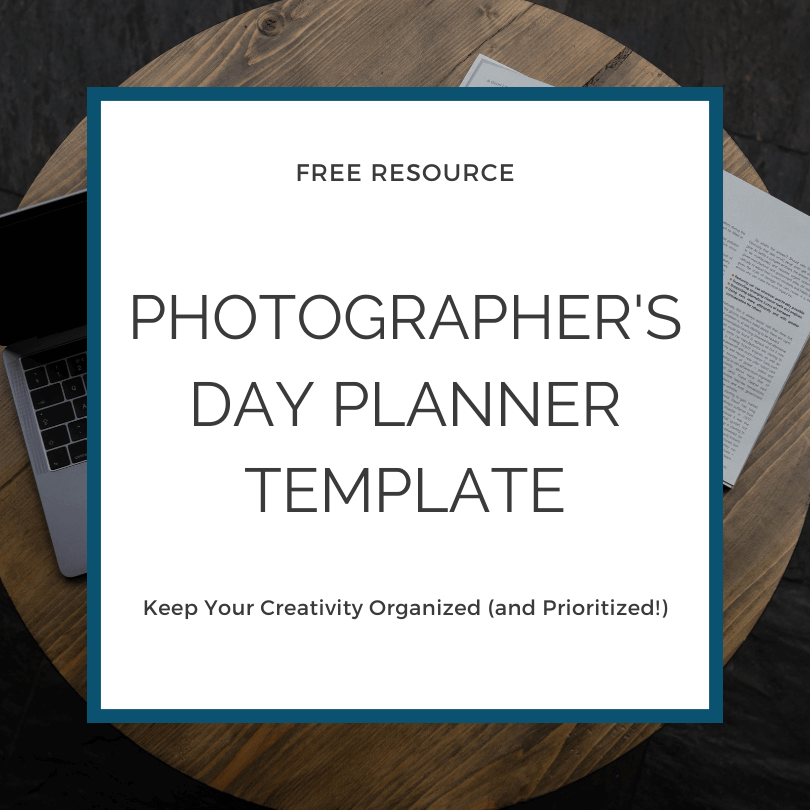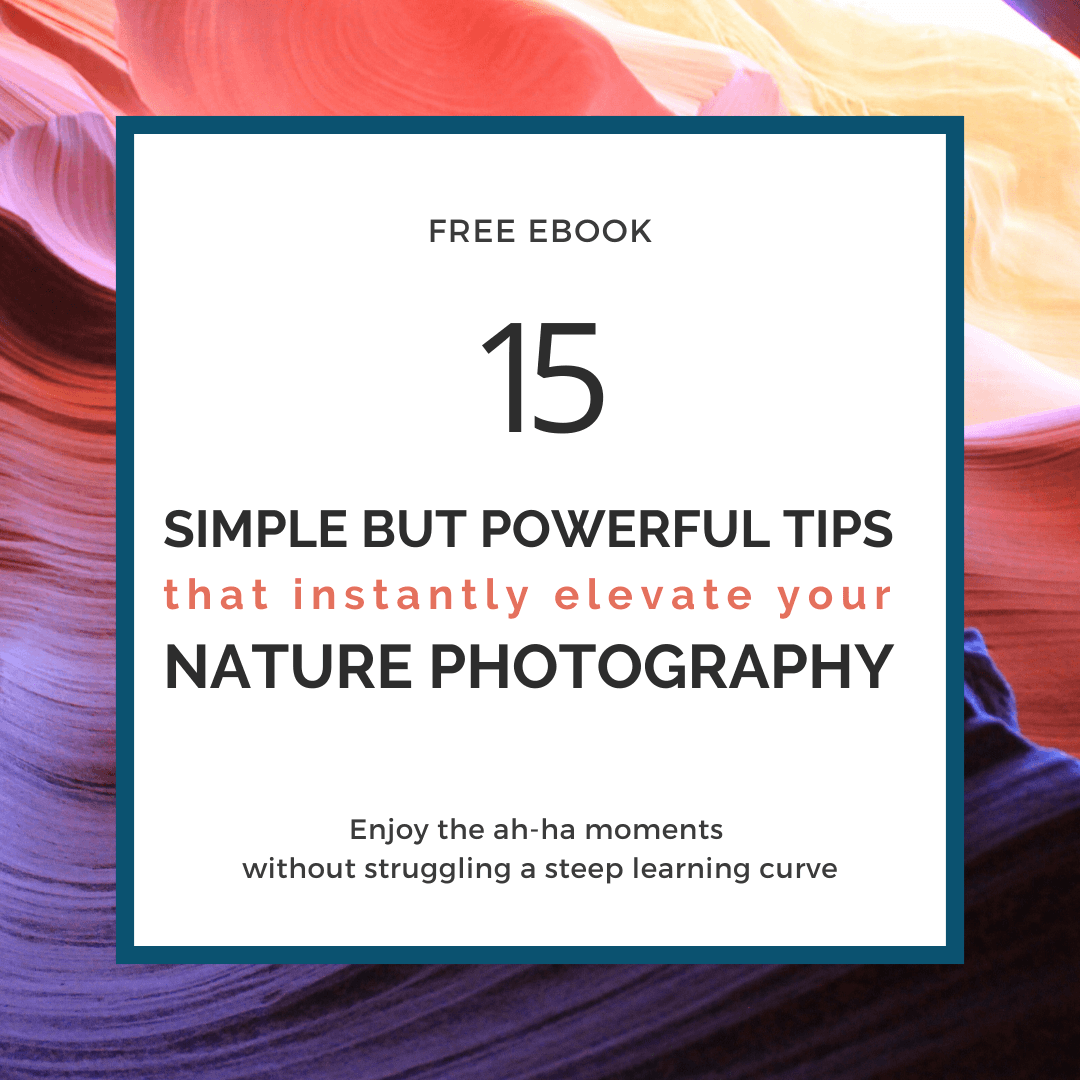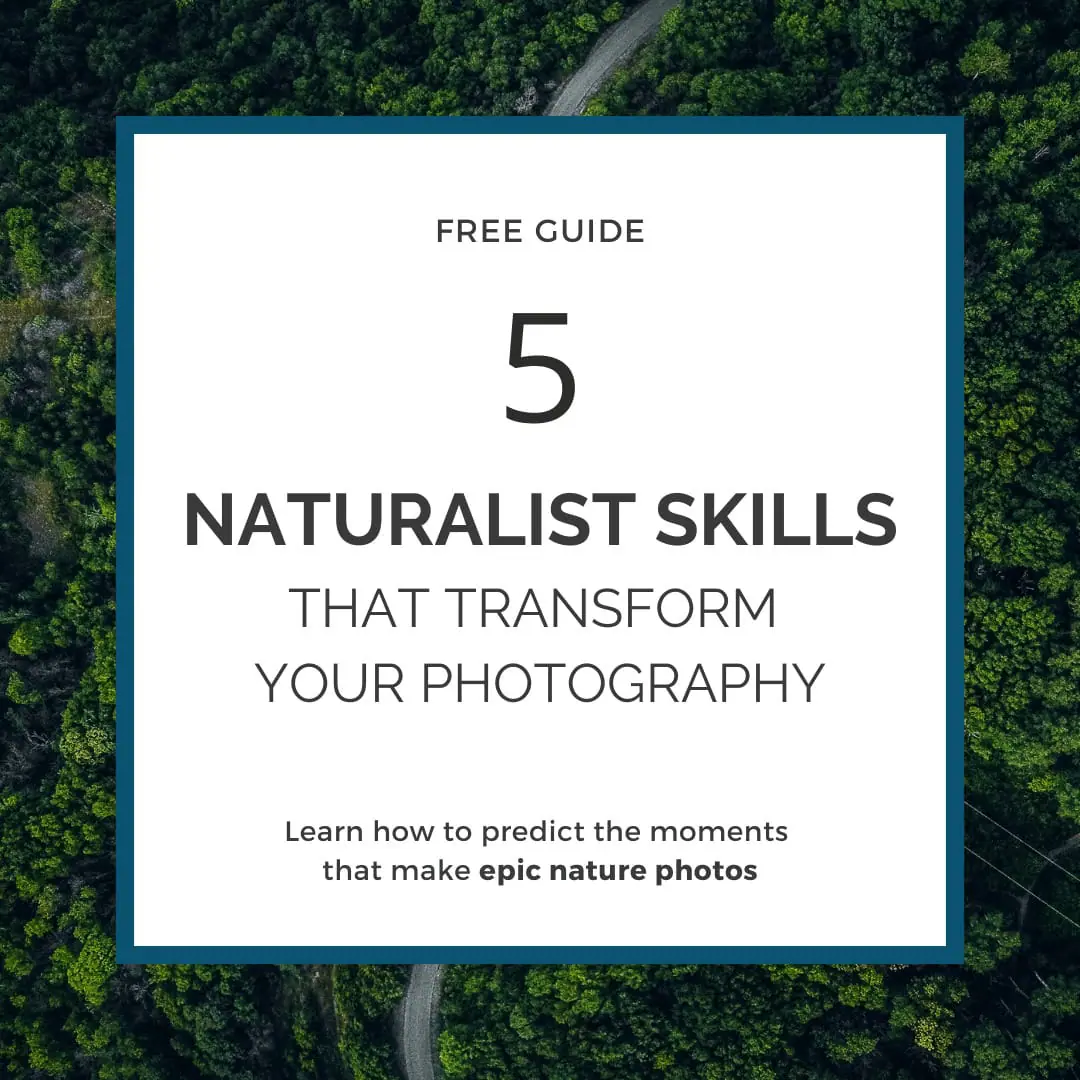How to Be a Better Volunteer with These 7 Business Mindset Strategies
Use business mindset strategies to become an even more effective, joyful, and respected volunteer conservation photographer with your favorite local organizations.
Benefits of volunteering as a conservation photographer
Are you eager to dive into the world of conservation photography, gain valuable experience, and make a difference?
Volunteering is an excellent way to do just that!
But before you jump in headfirst, it's essential to approach your volunteer work with a business mindset.
This will not only protect your interests and the value of your work but also ensure that both you and the organizations you partner with are set up for success.
Volunteering offers numerous benefits, especially for those just starting in conservation photography.
It provides opportunities to:
- practice storytelling
- hone your photography skills
- build a portfolio
- make essential connections
In my own experience as a volunteer, as well as observing other conservation photographers, a business-oriented approach to volunteering can lead to paid opportunities.
This could happen either directly through the organization you volunteered for or via recommendations and collaborations they connect you with.
However, it's crucial to have open conversations and set clear expectations and boundaries with the organization you're volunteering for.
By treating your volunteer work with a business mindset, you can avoid potential pitfalls such as organizations taking advantage of your time or using your images without proper licensing agreements.
This approach helps maintain the integrity of your work, as well as conservation photography as a respected field where professionalism matters.
So, let's embrace the power of volunteering while being mindful of its potential challenges. By doing so, you'll not only contribute to conservation efforts but also create a solid foundation for your own growth and success in this rewarding field.
I have seven business-minded tips to help you make the most of your conservation photography volunteer efforts, ensuring benefits for you, the organization, and the cause.
7 Business strategies to use when volunteering
1. Have open conversations from the beginning
I understand that approaching a new organization for volunteering might feel intimidating, and you may be hesitant to ask questions or express your ideas. However, remember that you're managing a business (or a business-like hobby!), and it's crucial to enter any meeting knowing what you'd like to offer and gain.
Before approaching an organization, consider the type of imagery you want to provide – whether it's covering events, documenting field work, creating branding images, or photographing their work as part of a story idea. Get clear on what you are and aren't willing to do as a volunteer.
When you initiate the conversation, come prepared to listen first, then present ideas that fall within the scope of volunteer work you'd like to do.
So, rather than simply stating you're a photographer looking to help, instead ask what their needs are, and listen carefully to their responses. Then map out ways you can help, and present those ideas in a professional manner.
This sets a tone of openness and trust, which is essential for a successful collaboration.
Remember, being clear and transparent is kind, while being vague is unkind. Being upfront about your intentions and expectations allows both parties to understand each other's needs and build a solid foundation for future cooperation.
So, don't be afraid to express your thoughts and establish trust from the very beginning.
2. Set your boundaries
Consider the boundaries you'd like to establish when volunteering your time and skills. Ask yourself:
- How many hours per week or month do you want to dedicate to volunteering as a photographer?
- What kind of services will you provide, and which ones will you not offer as a volunteer?
For example, you may be interested in photographing an organization's fieldwork but not their events. Be clear about the types of photography you're willing to do and those you'd prefer to avoid.
Additionally, think about how you'd like the organization to use the media assets you provide. Determine what you're comfortable with, such as:
- Are you okay with them using your images on their website, but not on social media?
- Are you fine with social media usage, but not third-party distribution to media outlets?
By setting boundaries and communicating them openly, you establish trust with the organization, ensuring that everyone's expectations are understood and met. This transparency helps avoid unpleasant surprises and fosters a strong collaboration where both parties benefit.
Remember, being clear is kind, while being vague is unkind. Open dialogue allows you and the organization to navigate expectations together, creating a successful volunteer experience for all involved.
3. Communicate the mutual benefit to the organization
Adopting a business mindset when volunteering means understanding that both parties should benefit from the collaboration.
By clearly showing how your services provide value to the organization, you ensure that they appreciate your work and don't take advantage of you.
To communicate mutual benefit, first, explain how your photography will benefit the organization.
For example, if you want to document fieldwork, describe how the images can enhance their social media engagement, impress funders in an annual report, or support their grant applications.
This demonstrates that you're genuinely trying to help them and not just using them for your portfolio.
Second, if the organization asks you for additional tasks, discuss what you would like in return.
For instance, if they want you to photograph a fundraising event, request a licensing agreement that includes photo credits, social media tags, and model releases for workers involved in the activities. While there might not be monetary compensation, these non-monetary benefits can still hold great value.
Being clear about the benefits for both parties creates a healthy give-and-take relationship where everyone is aware of their responsibilities and boundaries.
This approach ensures a successful, mutually beneficial collaboration where no one feels taken advantage of.
4. Implement licensing agreements
As the saying goes, “good fences make good neighbors.” The same applies to licensing agreements for donated images. These agreements provide clarity on how images can or cannot be used, protecting both parties.
Having a licensing agreement in place is vital, even for donated images. If an organization uses your images in a way you didn't agree to, you have written documentation to address the issue in a friendly manner.
I've personally experienced the benefits of having a licensing agreement with an organization I volunteered for. They respected the agreement and always checked with me about image usage requests, leading to paid licensing opportunities and donations for them.
Clear parameters in writing ensure mutual benefit and protect your rights as a photographer.
Moreover, having a licensing agreement in place can help you revoke image usage if you decide to sever ties with the organization.
So, even when donating images, always have a licensing agreement in place. This ensures clear boundaries and provides guidance on next steps if any issues arise.
Remember, licensing agreements are essential, but they're not the only paperwork to consider.
5. Obtain model releases
Model releases are crucial if you plan to use your images for non-editorial purposes, such as selling or licensing them for commercial use, entering contests, or submitting to stock agencies. Additionally, model releases are beneficial for the organization, as they might need them for fundraising or promotional purposes.
By obtaining signed model releases, you're helping everyone involved, even when volunteering and providing a portfolio to the organization. You never know how you'll want to use those images in the future, so having model releases is a smart way to protect yourself.
Although managing model releases may seem daunting, there's a handy app called Easy Release that can simplify the process. With this app, you can generate model releases, property releases, and other paperwork on your phone or tablet. People can sign directly on your device, and you can email copies to yourself and them. This eliminates the need for physical paperwork and ensures you always have your releases organized and ready to go.
6. Don't be afraid to walk away
In business, they say “hire slow and fire fast,” and that's true for volunteering too.
If you feel the collaboration isn't working – whether it's not enjoyable, the organization doesn't value your efforts, or you've outgrown the partnership – it's okay to part ways amicably.
In fact, it's better for everyone if you don't let the relationship wither and become awkward.
7. Don't be afraid to ask for paid work
If everything is going well and everyone is happy, don't hesitate to ask for paid work when the opportunity arises.
If you see a chance to provide something special to the organization, like creating a promotional video, pitch it to them along with a budget. You can suggest hiring you for the project or applying for a grant together to cover the costs.
If the organization proposes a project that you're excited about but goes beyond your volunteer boundaries, don't be afraid to discuss payment. A strong relationship with the organization should allow for open conversations about scope and budget.
By being clear about your boundaries and expectations, you create an environment where both parties can thrive and grow.
Conservation photography offers an opportunity to give back and be a part of something larger than ourselves. When done in the right way, it can lead to a fulfilling experience that benefits both you and the organization.
It's essential to take time leading up to your volunteer efforts to get clear on what you need from the experience and how expectations can be met on both ends.
Providing the information requested clearly, being confident in your abilities, and being available when called upon are all ways to ensure a successful conservation photography volunteering venture.
Ultimately, remember that you are taking part in something bigger than yourself; having passion for the cause is just as important as skill!
Your work can have real impact, while also providing a platform for growth of your career. There’s nothing quite like making an impact doing what you love, so don’t forget to enjoy every step of the journey, too.
Resources Mentioned
Episode 047: How to Be a Better Volunteer with These 7 Business Mindset Strategies
Shownotes: ConservationVisuals.com/47
(Digitally transcribed, please forgive any typos)
Jaymi Heimbuch:
Volunteering is a fantastic thing to do as a conservation photographer, especially if you're just getting started. I mean, you're looking for a chance to get some experience under your belt to build up a portfolio, to make connections that could lead to more opportunities down the road. And of course, I think we all just have that drive to be helpful, right? But when you launch into volunteering, without having thought very far ahead, without having sat down with the organization or the group or the person that you want to volunteer with for some clarifying conversations, without having put some boundaries in place, or without having put some paperwork in place, then you actually run the risk of undermining yourself and your work, and even the field of conservation photography in general. So in this episode, we're going to talk about strategies that help you to become an even more effective, reliable, and productive volunteer setting yourself and your partner organization up for success all by approaching your volunteer work with a business mindset. All right, let's dive in.
Welcome to Impact the Conservation Photography podcast. I'm your host, Jaymi Heimbuch. And if you are a visual storyteller with a love for all things wild, then you're in the right place from conservation to creativity, from business to marketing and everything in between this podcast is for you. The conservation visual storyteller, who is working to make an impact. Let's dive in
If you are working to be an effective and influential conservation visual storyteller, but you're feeling maybe a little bit lost on that path or you're getting started. And you're not really sure what exactly you should be focusing on right now or next in that journey. Well, I have a brand new completely free masterclass for you. It's called the five point path to become an effective and influential conservation visual storyteller. This masterclass is all about how to make a positive impact for conservation as a nature photographer or filmmaker without getting sidetracked by your busy schedule, without getting lost in all of those. How do I questions or wasting time wondering about the best things to focus on right now, if you've been focused on becoming a more influential conservation visual storyteller, or if you are already on that journey, but you're feeling like you've lost focus or you're feeling like you've lost direction, then this masterclass is absolutely for you. You can register for free at wildidealab.com/path. That's wildidealab.com/path. I know that you will get a ton out of this. I even have a little time savvy strategy hidden inside of this masterclass for you that can help you hit some goals and be really productive, even if you only have a couple hours a week to dedicate toward your creative endeavors. So again, you can register at wildidealab.com/path All right, let's get into this episode.
Hello. Hello and welcome back to the podcast! Thank you so much for tuning into this episode. I'm really excited that you're here and I'm actually feeling just excited in general right now for the last couple of weeks. I've been really hard at work. I've been revamping conservation photography 101. This is my digital course, and I've been adding in new lesson material. I've been adding a new resource material. I've actually rerecorded the entire course, and I've just been having a blast making this an even beefier course than it already is. I even created a new bonus course that I'm super excited about, but I think ultimately I'm really excited because I've set a date for when the next enrollment opens. So are you ready? Do you have your calendar out with your red pen because conservation photography 101 will open for enrollment on January 6th. So January 6th is the big day.
If you want to be first in line to know when enrollment opens, there's a wait list. You can hop on the wait list at conservation photography, courses.com. And on top of this, there's actually been a whole lot more going on lately. And that's actually what had me thinking a lot about today's topic. It made me want to talk a bit about volunteering. So volunteering is something that pretty much all conservation photographers do at all stages of our work, whether we're just getting started or as part of the way that we give back during our career. But volunteering is really an especially good idea when you are just getting started and you need a way to gain some experience in how to photograph people or events or science or field work and all that good stuff.
It's a chance for you to kind of create your own opportunities to practice storytelling, photography skills, to practice techniques, to build up that portfolio of images that really show off your skill sets. And importantly, volunteering can also get you connections. It can get you opportunities to network or to find story ideas or access to story ideas that you might end up wanting to pitch for publication. These are all really great things, right? But what I see happen so often is, you know, you have all this eagerness to just get your foot in the door or to just get active, doing something good. And that means that you can skip over some really, really important conversations, which then opens you up to the possibility of this volunteer effort actually of undermining you in the long run and by volunteering in certain ways, it can even undermine conservation photography as a field, as a respected field where behaving a professional matters, right? So I've so often seen that new photographers can sometimes plow forward with a volunteer opportunity only to realize that the organization is starting to take advantage of them or expect even more time or photo assets from them than they'd ever really intended to provide. Or maybe the organization just assumed that they could do anything that they want with these images that are handed over. So they're giving them a way to media outlets or of publications without checking in with the photographer or allowing the photographer, the opportunity to negotiate a licensing fee for Those images. So
Losing out on these future paid opportunities, because this organization has given away your images, it's kind of a big deal and you could be losing out on getting paid by that organization itself for producing work that goes above and beyond your volunteer efforts. I mean, none of that feels good, right? And this kind of Willy nilly wandering into a volunteer position can also undermine the value and the importance of professional level photography has volunteering, especially really extensively volunteering takes potential assignments or licensing opportunities away from professionals and yes, away from you, if or when you decide that you want to earn some money through your work, see it sets this expectation by the organization that they should be getting all of their media assets for free. They'll never have to pay for them, but the thing is high quality materials that professionals and professional level volunteers like you produce could actually have these amazing benefits for nonprofits. These assets can help them get more exposure to a bigger audience base, get in more donations, win bigger grants. But these organizations may continue to never realize that investing in professionals can pay off enormously because they're just getting these media assets for free. So giving away the goods without really thinking about how you're approaching, this can be really problematic, but all that said, I'm going to return back to the fact that volunteering is often an extraordinary, truly beneficial thing to do. It's something that can open up doors for you and you're starting out. And even when you're a pro, looking for additional opportunities to contribute to conservation, volunteering is awesome, but you do need to approach volunteering as if you are a business and you're taking a business mindset. And when you do go into it with more of a business mindset, well, it causes you to have open conversations that set clear expectations and boundaries. The organization knows what it can expect to get from you. And if it wants more than that can be negotiated, it also helps you to think about the helpful paperwork that ensures that you avoid future hiccups, like licensing agreements for your donated images. So the organization knows how they can, and can't use images and model releases so that you know how you can, and can't use your own images later on down the road.
And you know, both in my own experience in volunteering for various organizations, as well as witnessing it with other conservation photographers. When you take a business oriented approach to your volunteer efforts, you can actually land paying gigs or other great paying opportunities, either directly with the organization who may hire you to create additional media assets for them, or thanks to them, recommending you for collaborations that maybe they hire you to be part of or recommending you to businesses that then want to hire you to create media assets. So there is really no downside to thinking in a businesslike way, even when approaching your volunteer efforts, but what does that look like? Well, I have seven business-minded tips for how to approach your conservation photography volunteer efforts so that everyone benefits you benefit the organization, benefits the cause benefits. So let's dive in to these seven tips.
Tip number one is to have open conversations from the start. Now I know that it's really common to be a little bit nervous when asking an organization about being involved. Like if you are just approaching a brand new organization, you've never worked with them before you might feel shy, or you might not want to put anyone off and you really just want to get your foot in the door, but that's not how you'd manage your business. Right? If you're putting on your business hat, then before you walk into a meeting, you know what it is that you'd like to provide and what you hope to gain. And it's important to have that worked out in your head, even before you approach an organization for volunteering, for instance, what kind of imagery do you want to provide to this organization? Do you want to cover their events for them so that they have some marketing materials, or do you want to document their field work so that they have images for their website to show what they do, or maybe you want to create branding images for them, or maybe you want to photograph their work as part of a story idea that you'll pitch to bring them even more exposure, whatever it is that you want to do for this organization know that before you approach them, I mean, it might not be what ultimately pans out after you started on conversations, but at least you aren't going into that first conversation as just this blank slate you, aren't showing up being like, Hey, I'm a photographer.
I want to help point me in a direction you're coming in saying, Hey, I'm a photographer. I want to help. I have these ideas about the way is that I would like to help. What do you think? And in that first conversation, it's also really important to set a tone of openness and trust. I mean, this is truly essential to build a solid foundation for any future collaboration. I remember hearing once somewhere clear is kind unclear is unkind. And that is really the truth here. Being clear about what you would like to create for them. And indeed why you would like to that for them. Like if you're hoping to get photography experience or you're interested in helping them fundraise, whatever it may be being really clear about that and being super open so that they feel free to be clear with you about what they want and what they need and what they can do handle for their volunteering.
That's going to help to set this tone for all future conversations that you can say what's on your mind and the everything's out on the table, it's going to establish trust right away. Now tip number two, after you've set up all that clarity about what it is that you would like to do for this organization, what they would want from you. Well, the next step is to say boundaries first, do this on your own. So think about what boundaries you want to create as, and how many hours a week or a month do you want to dedicate to volunteering as a photographer? What kind of services are you going to provide and what will you not provide as a volunteer? So maybe your boundaries are, you know, that you want to get out and photograph fieldwork and on the groundwork that the organization is doing.
And that's great. And you don't really want to photograph their events. Like it's just not your thing to do event photography. Well, that can be a boundary that you have really clear in your head. Like, you'll do this type of photography, but you just don't want to do that type of photography also about how will you allow the organization to use the media assets that you provide to them? Like what makes you, I feel comfortable or uncomfortable. So be really clear. Are you comfortable with this organization using images like on their website, but maybe you're not comfortable with them using them for social media or maybe you're perfectly fine with them using it for social media, but you know that you don't want them to just hand them out. Do third party organizations like media outlets will be really clear about that in your head as well.
And after you have these boundaries clear in your own mind, then be very clear in communicating that to the organization. So if necessary specify to the organization, what goes beyond the scope the work. So let's say for instance, you can under this conversation and you have the capacity to dedicate about five hours a month to document some of this organizations, let's say it's a native plant restoration group. You have about five hours a month that you'll dedicate to documenting this and you'll provide them with that. They're allowed to use for their own marketing and fundraising purposes, but they can't provide them to third parties like media outlets. They need to refer those requests. You for any licensing, remember clear as Kai and unclear is unkind and good fences make sense neighbors. So when you set clear boundaries, you're actually helping to establish even more trust with an organization because you're putting it all out on the table.
You're being very open with expectations and everyone can be on the same page. You're creating the opportunity for them, them to tell you what they want from you and what their expectations are. And you can kind of navigate that together. They're in this really open way. You're basically showing that you're happy to talk about anything and that you're also game to avoid unpleasant surprises, right. And everybody can be down with avoiding unwanted surprises. Right? So tip number three is once you've established this really clear open conversation and you've set some boundaries. Now, you also want to be clear on mutual benefit. Okay. This is definitely a business mindset strategy. Yes, you absolutely want to be of service to an organization, but there is no ethical conundrum of receiving a benefit in return. I mean, that's really the whole point of volunteering, right? We volunteer knowing that we're going to get something in return, whether that's good vibes or experience or whatever it is.
So setting up the potential for any trade really means showing very clearly how your services are providing a benefit to the organization, because this helps to ensure that they don't take advantage of you or just disregard the importance or the value of what it is that you're providing. And you're also helping the organization to understand in this very kind way, why they need you and how you're bringing something awesome to their doorstep. So they don't feel like you're just using them. So by being really clear about this mutual benefit, that helps to create this really lovely give, take relationship where everybody understands that no one's getting taken advantage of, and everybody's getting something in return. So how do we accomplish this? Firstly, if there's something that you want to do for this organization explained to the org, how it will benefit them, think about it as if you are walking into a business meeting, doing a presentation for a business client.
So if you want to get access to field work to document it, explain the ways that the organization might use that portfolio of images. So maybe it's for increasing the engagement on their social media account by showing the behind the scenes work that they're doing, or maybe this gives them images that they can include in their annual report, that'll really impress funders, or they can use the images to build a really amazing visual presentation that they'll add into their next grant application. So it taking this extra step to show an organization how, what you're creating can benefit them and showing them the ways that they can use this to build value that ensures that the organization sees that you've really thought things through and that you're trying to help them and not just take advantage of them. Yeah. Maybe use them to build your portfolio, but they're not really getting anything in return.
You're showing exactly how they're getting something amazing in return. So they really end up actually valuing you a lot as well. Now, secondly, if there's something that they want you to do, we'll discuss how you would like to benefit as well. So say you're volunteering for this native plant restoration organization and they're planning this big fundraising drive with a seedling sale. And let's say they want you to come and photograph all the plants in their demonstration garden and some of their restoration activities. So they have these great images to go with their promo material and their social media posts that lead up to the event. Well, okay, great. That sounds wonderful. And in return for providing, you want to make sure that you have a licensing agreement for them to sign. That includes the, you'll get a photo credit listed under the images, wherever they're used in their promo materials.
And you want to be tagged in any social media posts that use your images. And let's say, you'd also like to make sure that you have model releases for any of the workers that are going to be at this restoration activity, because you would like to use these images on your website portfolio to show that you are doing the storytelling project, whatever it is that you want to receive back, just make sure that that's outlined and it might not be any monetary compensation, but these little things can be of great value to you and can really make it feel like a very even trait. And here's the other thing being clear about what you would like as a benefit for doing this extra volunteer request. It reinforces the fact that you do have boundaries that you've established and that this is kind of an out of scope thing, but you're willing to do it.
And it shows that you're happy to volunteer, but you recognize that your work brings value. And so a trade is reasonable. So whenever they have a request for you, that's kind of above and beyond your usual volunteer efforts, you're going to be asking for that trade in return. And that creates a really healthy give and take kind of status of this relationship, this collaboration. Now I mentioned earlier, the idea of establishing paperwork and that is my next tip. A licensing agreement always put licensing agreements in place. Like I always say good fences, good neighbors, and a licensing agreement, even for donated images, things out in no uncertain terms, how images may or may not be used, the licensing agreement provides that kind clarity. Right? And it also is really because if an organization uses images in a way that you didn't agree to, will you have it in writing and a way to correct that issue that can be still done very friendly, right?
I mean, this has come in handy for me, many times, I volunteer with one group that I absolutely adore, not only because they are just exceptional beings, but also because they really respect those licensing agreements. They're constantly checking in with me about requests that they've received for images and if they're within their licensing parameters or if they need to refer those requests to me, they are just so amazing and respectful. And that amazingness has actually led to paid licensing opportunities for me as well as donation opportunities for them. Because sometimes when I negotiate with a third party for a licensing agreement, the payment is simply a donation made to that organization. So it really makes sense for us to have very, very clear parameters in writing about how donated images can and can't be used. And it it's a mutual benefit. And also on the flip side, having a licensing agreement in place has been really helpful because in one instance, I was able to revoke the use of my images by an organization that I no longer wanted using my donated images. So it was a way to really cleanly cut ties. So licensing agreement super important, even if you're donating images, put a licensing agreement in place, and if things get complicated or they go sour or there's any sort of confusion, you have really clear language that dictates boundaries and next steps and licensing agreements are not the only paperwork I suggest having in place tip number five is to also obtain model releases. So model releases are really important if you plan to use your images in any non editorial manner. So let's say you plan to sell images or license your images for use in commercial endeavors, or even if you plan to enter your images in contests or to stock agencies. It's great to have those model releases in place. And it's also super helpful for the organization too, because if they want to use images for fundraising or for promotions, they need to have model releases signed by whomever's in that image.
So you're actually helping everyone out by getting model releases signed, even if you're volunteering and handing over this whole portfolio to the organization, get those releases because you don't necessarily know how you'll want to use those images in the future. And those model releases are just a great way to cover your rear. Now, I know that the idea of trying to figure out model releases might sound really annoying, but there's actually a really great app that I liked to use. It's been around for a long time. It's while loved, it's called easy release and easy release an app that you can have on your phone or your tablet split device. And you can generate model releases, property releases, and some other paperwork right there. You can have people sign it on your device and you can even email copies to yourself and to them. So it's a great way to never have to cart around paperwork, or, Oh, you forgot your folder of model releases at home today or whatever.
You always have that handy and ready to go. And it keeps all of your releases really organized. So I will link to this app in the show notes. So you can go to jaymih.com/47, Number 47 for this episode and grab links to easy release and any other resources that I have for you from this episode. Now my next business mindset tip is don't be afraid to walk away. If it isn't working out in business, they say hire slow and fire fast. And that's true in volunteering too, you enter a collaboration with your eyes wide open. And if for any reason you feel like this isn't a fit, whether it's just not very enjoyable photograph with this group, or you feel like they aren't really valuing your volunteer efforts, maybe they're constantly asking you for more than you can really provide, or maybe you've just outgrown the collaboration.
And you're not that stoked on this organization anymore. It's okay to shake hands and to move on. And in fact, it's better for everyone. If you don't let things kind of wither on the vine and get awkward, right? So don't be afraid to walk away if it isn't working out. I know that sometimes you can get a little bit hung up on, um, volunteering with an organization, kind of sticking it out. You feel like you should help out, or you should stay on, but if it isn't right and you know, in your gut, it's just not a fit anymore. Then it is okay and reasonable to go ahead and shake hands and cut ties. And my last tip is if everything's working out really well and everyone is super happy, then don't be afraid to ask for paid work. I mean, you might see a truly amazing opportunity for you to provide something special to this organization.
Say you want to create a promotion, no video. That would be this huge benefit to bringing in new donations in a fundraising effort. Well, creating a promotional video requires a lot of time and energy on your part, but you also know that it would provide a huge benefit to the organization. So you could actually pitch this to them along with a budget, either as something that they consider hiring you to do so, not as a volunteer effort, but as something that is kind of above and beyond and that you can budget for, or maybe you can pitch it to them as something that together you'll write a grant that would cover paying you to create this promotional video, or let's say the it's the organization that comes up with project that they really want you to do. And you are so game to do this.
Like, it sounds so much fun. You'd learn a lot, you'd have a blast, but it would again be above and beyond the boundaries that you set for your volunteer efforts. Well, don't be afraid to say, yeah, this sounds amazing, but this is something that we would need to discuss payment for. So let's talk about the scope and a budget that feels comfortable, right? Well, if you've got a really great relationship going with this organization, then they should be super open to hearing this response from you and hopefully opening up the conversation. So again, you've established this relationship, you've been really clear. You've set these boundaries. Everybody knows what it is that you are there to volunteer to do. And if something really big and extra comes along, it's okay to say, you know what? That big extra thing, that's a paying gig. Let's talk about what that would look like in terms of budget and payment and how we'll fund that.
All right. So let's go through these business mindset tips once again and again, they are truly intended to help make your volunteer efforts more effective, more smooth, more respected, more fun. And these are tips that are learned through experience from myself and from others in the field. So they are number one, have open conversations from the start. Remember that clear is kind and unclear is unkind. So these open conversations establish trust right away and get you started on the right foot. Tip number two, set clear boundaries. First, get clear in your own head about what boundaries you want to have going into volunteering, and then establish those boundaries with that organization. Again, be really clear about what it is that you expect to do, what you can and can't do as a volunteer in terms of time or ability or what you want to do as a volunteer and be super clear with setting those boundaries with the organization, tip number three, clarify the mutual benefit.
So if you want to do something for the organization, explain how it helps them. And if they want you to do something for them, establish what you get as trade tip. Number four and five are getting those licensing agreements and model releases in place. This is all about maintaining clarity and boundaries and legal parameters about what you create. This paperwork is not intended to make anything more awkward or difficult. It's actually intended to make sure that everybody's on the same page and everybody knows what document to fall back upon. If something were to pop up, tip number six, if it isn't working out, it's okay to walk away. And in fact, do the sooner rather than later, so that you can maintain really good relationships and not end up feeling negative things like resentment or awkwardness or whatever, as often as possible. You want to end on that good note and last but not least, if you've created a really great relationship with an organization and an opportunity for bigger projects pops up, it's okay to talk about this as a paid endeavor.
I mean, this has been the case for me and quite a few folks that I know that we volunteer within certain parameters and we are paid when work goes beyond those parameters. And because we've established such a great relationship with the organization, this is a no brainer move. All right? I hope that you enjoyed this episode and that it's provided you with some food for thought as well as strategies that you can use to make your volunteering experiences so much better. And as always, I'm so grateful that you listen in each week. You're wonderful. And you can also grab links to the resources that I mentioned in this episode, in the show notes, you can find those at jaymih.com/47. And meanwhile, I will talk to you next week.
Before we wrap up. I would love to ask you to do one quick thing, subscribe to this podcast as a subscriber. You'll not only know when each week's episode goes live, but you'll also get insider goodies like bonus episodes. You might miss them unless you're subscribed, and I don't want you to miss out on a thing. So please tap that subscribe button and I will talk to you next week.
________________
Impact: The Conservation Photography Podcast
JaymiHeimbuch.com/Podcast
